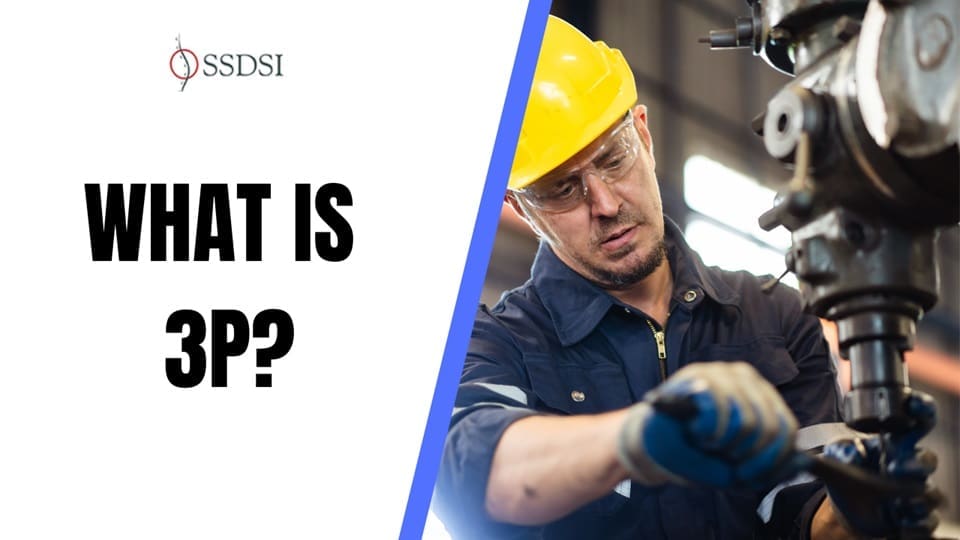In Lean manufacturing, the term 3P refers to Production, Preparation, and Process. It is a methodology used to design and develop efficient production systems.
The goal of 3P is to create a production system that reduces waste, increases efficiency, and improves product quality by focusing on detailed preparation and process design. It is applied primarily in the early stages of product development and production setup.
Unlike traditional methods that address problems after they arise, the 3P approach is proactive. It anticipates potential issues and creates solutions before full-scale production begins. By focusing on Production, Preparation, and Process, Lean organizations can make their operations more efficient and make sure everything is ready for success.
Table of contents
Concept of 3P
In Lean, the 3P methodology ensures that companies create production systems that are not only efficient but also adaptable and sustainable. It aims to optimize the entire system from the start. The approach involves designing the product, the process, and the preparation activities necessary for production.
The 3P process is typically broken into three parts:
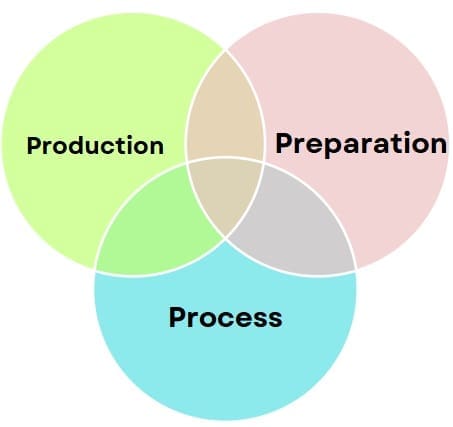
- Production: Designing the product and the production system.
- Preparation: Preparing for production through planning, testing, and tool setup.
- Process: Designing efficient and standardized processes for manufacturing.
By addressing these areas ahead of time, the 3P methodology prevents inefficiencies and improves the overall flow of production.
Production in 3P
The Production phase of the 3P methodology involves designing both the product and the production system. It’s about ensuring that the product can be made properly and that the production system works quickly and efficiently. This phase sets the foundation for everything that follows.
Key Elements of Production Design

- Product Design for Manufacturability: The product must be designed in a way that is easy to produce. Simple designs with fewer components make production easier and less error-prone. The product must also meet customer needs without overcomplicating the design process.
- Designing the Production System: This involves planning how the production system will operate. Teams design production lines, material flow, and workstations. This design is meant to reduce downtime, improve cycle times, and enhance flexibility.
- Prototyping and Testing: Before starting full-scale production, the team creates and tests prototypes of the product and production system. This helps identify design flaws, potential production bottlenecks, and areas for improvement. Prototypes allow companies to test their assumptions and make adjustments before mass production begins.
By designing products with manufacturability in mind, businesses can ensure smooth production and reduce the risk of errors during manufacturing.
Preparation in 3P
The Preparation phase focuses on making sure everything needed for production is ready before actual manufacturing begins. This phase involves planning, tool setup, training, and material flow. Preparation is crucial because it establishes the groundwork for a smooth production process.
Key Aspects of Preparation
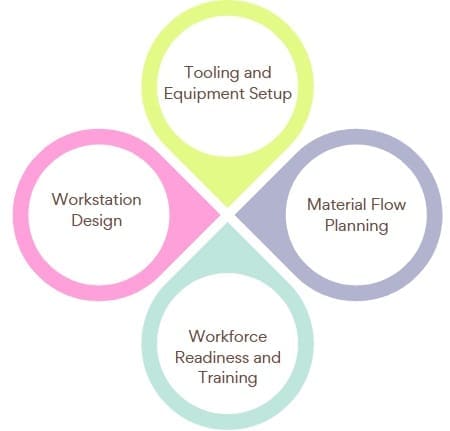
- Tooling and Equipment Setup: Before production starts, it’s essential to ensure that the right tools and equipment are in place. This includes designing and testing the necessary machinery, jigs, fixtures, and automation systems. Equipment must be capable of meeting production demands and running efficiently without failure.
- Material Flow Planning: Efficient material flow is critical for minimizing waste and reducing downtime. This involves designing how materials will be sourced, transported, and stored. Proper planning ensures that materials are available when needed, reducing the chances of stockouts and delays.
- Workforce Readiness and Training: Employees must train and prepare to execute the new processes. Preparation also includes organizing teams, assigning roles, and making sure workers understand their responsibilities. Cross-functional teams, including engineers, operators, and designers, collaborate during this phase.
- Workstation Design: The design of workstations must facilitate efficiency. Design the workstations ergonomically and optimize them for smooth work processes. Place equipment, tools, and parts in logical, easy-to-reach locations to reduce unnecessary movements.
By thoroughly preparing for production, businesses avoid common pitfalls like resource shortages, equipment failures, and workforce confusion. This phase sets up a strong foundation for a smooth production flow.
Process in 3P
The Process phase involves designing and refining the processes used to produce the product. This includes developing standardized work processes, optimizing material handling, and eliminating waste. The goal is to create processes that are simple, repeatable, and effective.
Key Aspects of Process Design
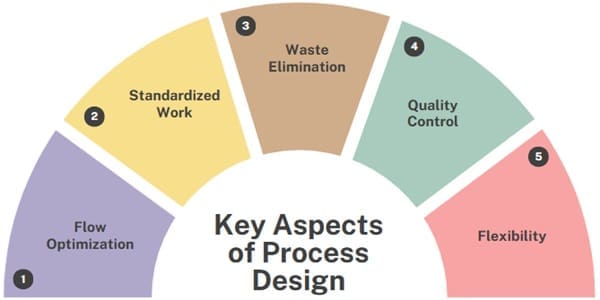
- Flow Optimization: The entire production process should be optimized for smooth, continuous flow. This involves designing production lines, minimizing waiting times, and eliminating unnecessary steps. Material handling systems should be designed to reduce transportation time and effort.
- Standardized Work: Standardized work is the backbone of Lean processes. It involves defining the most efficient way to perform each task and ensuring that every operator follows the same steps. Standardization reduces variation, improves quality, and helps identify areas for improvement.
- Waste Elimination: In Lean, waste refers to anything that does not add value to the product or process. The process phase focuses on eliminating waste in all forms, such as excess inventory, unnecessary movements, and overproduction. Techniques like Value Stream Mapping (VSM) are used to identify and address inefficiencies.
- Quality Control: Processes should be designed to ensure high product quality. This involves building quality into the process by using techniques like Poka-yoke (error-proofing) and implementing continuous quality checks.
- Flexibility: The production process should be flexible enough to handle changes in demand or design. Lean systems prioritize adaptability, so processes can quickly adjust to new conditions without significant downtime.
By focusing on process design, companies create an environment where production runs smoothly, waste is minimized, and quality is consistent.
Also See: Lean Six Sigma Certification Programs, Fort Wayne, Indiana
Key Tools Used in 3P
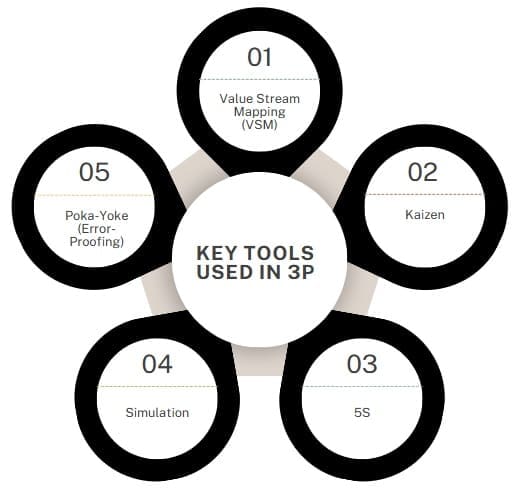
Several Lean tools and techniques are applied during the 3P methodology to ensure effective production, preparation, and process design:
- Value Stream Mapping (VSM): VSM identifies and visualizes all the steps in a production process. It helps highlight areas of waste and inefficiency, allowing teams to develop more streamlined processes.
- Kaizen: A continuous improvement philosophy, Kaizen encourages small, incremental changes that lead to better processes over time. It is particularly useful during the process design phase.
- 5S: This is a workplace organization method that promotes cleanliness, orderliness, and efficiency.Teams often apply it during the preparation phase to set up workstations and ensure a safe, organized environment.
- Simulation: Before full-scale implementation, teams use simulations to test the effectiveness of a proposed production system. This helps identify potential issues and make adjustments without disrupting actual operations.
- Poka-Yoke (Error-Proofing): This technique prevents mistakes in the process. It designs processes that automatically correct errors or prevent them from happening.
Benefits of 3P in Lean
The 3P approach offers several advantages for businesses:
- Reduced Waste: By focusing on waste elimination during the design phase, 3P ensures that unnecessary steps are avoided before production begins. This leads to lower costs and faster production times.
- Increased Efficiency: Careful planning and process optimization result in faster, more efficient production systems. This reduces cycle times, speeds up time-to-market, and improves the overall output of the manufacturing process.
- Improved Product Quality: Companies test the product and process before full-scale production to ensure that quality is built into every step of the process. This leads to fewer defects and higher customer satisfaction.
- Better Flexibility: The 3P method encourages the design of adaptable production systems. This allows companies to respond quickly to changes in customer demand or production requirements without significant delays.
- Faster Time-to-Market: With better planning and preparation, production can begin more quickly, reducing delays and accelerating the delivery of products to customers.
Challenges in Implementing 3P
While the 3P methodology is powerful, there are challenges to its implementation:
- High Initial Investment: The preparation phase can be resource-intensive, requiring significant time and money for prototyping, testing, and training.
- Employee Resistance: Employees may resist changes to their routines, especially if they are unfamiliar with Lean principles. Effective training and communication are essential to overcome this.
- Complexity of Coordination: 3P requires collaboration between multiple departments, including engineering, operations, and design teams. Coordinating these teams can sometimes be challenging, especially in larger organizations.
However, proper planning, support, and communication can address these challenges.
Real-World Examples of 3P in Lean
- Toyota: As the originator of Lean principles, Toyota applies 3P to design and optimize its production systems. By focusing on Production, Preparation, and Process, Toyota has built some of the most efficient manufacturing systems in the world.
- Honda: Honda uses 3P to develop flexible and efficient manufacturing systems. Their 3P approach ensures that they design new products for manufacturability and optimize the production process before mass production begins.
Final Words
The 3P methodology—Production, Preparation, and Process—is an essential part of Lean manufacturing. It ensures that businesses can design efficient, effective, and adaptable production systems before starting full-scale operations. By focusing on proactive planning, testing, and process design, 3P helps eliminate waste, reduce costs, and improve product quality.
By implementing 3P, organizations can stay competitive, respond quickly to changes, and deliver high-quality products efficiently. The 3P approach is a powerful tool for achieving long-term success in today’s fast-paced manufacturing environment.

About Six Sigma Development Solutions, Inc.
Six Sigma Development Solutions, Inc. offers onsite, public, and virtual Lean Six Sigma certification training. We are an Accredited Training Organization by the IASSC (International Association of Six Sigma Certification). We offer Lean Six Sigma Green Belt, Black Belt, and Yellow Belt, as well as LEAN certifications.
Book a Call and Let us know how we can help meet your training needs.

